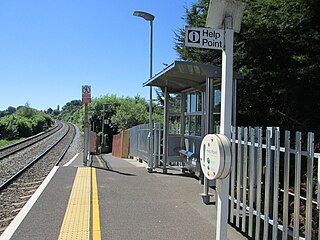
The Wessex Main Line is the railway line from Bristol Temple Meads to Southampton Central. Diverging from this route is the Heart of Wessex Line from Westbury to Weymouth. The Wessex Main Line intersects the Reading to Taunton Line at Westbury and the West of England Main Line at Salisbury.

Bedwyn railway station serves the village of Great Bedwyn in Wiltshire, England. It is 66 miles 33 chains from the zero point at London Paddington. Along with Pewsey station, it serves the market town of Marlborough which is 6 miles (10 km) away. A bus from the town connects with most trains on Mondays to Saturdays.

Feniton railway station serves the village of Feniton in Devon, England. It was opened by the London and South Western Railway (LSWR) in 1860 but is now operated by South Western Railway which provides services on the West of England Main Line. It is 159 miles 24 chains (256.4 km) down the line from London Waterloo.

Salisbury railway station serves the cathedral city of Salisbury in Wiltshire, England. It is 83 miles 43 chains (134.4 km) from London Waterloo on the West of England line to Exeter St Davids. This is crossed by the Wessex Main Line from Bristol Temple Meads to Southampton Central. The station is operated and served by South Western Railway (SWR), and is also served by Great Western Railway (GWR).

Dilton Marsh railway station serves the village of Dilton Marsh in Wiltshire, England. It is on the Wessex Main Line between Bristol Temple Meads and Southampton Central railway station, 23 miles (37 km) north of Salisbury. Great Western Railway manages the station and operates services between Bristol and the South Coast which call there.

Westbury railway station serves the market town of Westbury in Wiltshire, England. The station is managed by Great Western Railway.

Codford is a civil parish south of Salisbury Plain in the Wylye Valley in Wiltshire, England. Its settlements are the adjacent villages of Codford St Peter and Codford St Mary, which lie some 7 miles (11 km) southeast of Warminster.

Wylye is a village and civil parish on the River Wylye in Wiltshire, England. The village is about 9+1⁄2 miles (15 km) northwest of Salisbury and a similar distance southeast of Warminster.

Warminster railway station serves the historic market town of Warminster in Wiltshire, England.

Upton Lovell is a village and civil parish in Wiltshire, England. It lies on the A36, in the Wylye valley about 5 miles (8.0 km) southeast of Warminster. The parish is on the left (northeast) bank of the river, and stretches for over two miles northeast onto Salisbury Plain.
The Wilts, Somerset and Weymouth Railway (WS&WR) was an early railway company in south-western England. It obtained Parliamentary powers in 1845 to build a railway from near Chippenham in Wiltshire, southward to Salisbury and Weymouth in Dorset. It opened the first part of the network but found it impossible to raise further money and sold its line to the Great Western Railway (GWR) in 1850.

Ashton Gifford House is a Grade II listed country house in the hamlet of Ashton Gifford, part of the civil parish of Codford in the English county of Wiltshire. Ashton Gifford House is mentioned in the Wiltshire edition of the Pevsner Architectural Guides. The house was built during the early 19th century, following the precepts of Georgian architecture, and its estate eventually included all of the hamlet or tithing of Ashton Gifford. The house sits in the Wylye valley, part of the Cranborne Chase Area of Outstanding Natural Beauty.
The Salisbury branch line of the Great Western Railway from Westbury to Salisbury in Wiltshire, England, was completed in 1856. Most of the smaller stations were closed in 1955 but the line remains in use as part of the Wessex Main Line.
Wilton North railway station is a former railway station serving Wilton, Wiltshire, England. The station was opened in 1856 by the Great Western Railway on its Salisbury branch from Westbury. It was closed to passengers in 1955 and completely in 1965.

Heytesbury railway station is a former railway station near Heytesbury, Wiltshire, England, in the Wylye Valley, about three miles south of Warminster.
The Stert and Westbury Railway was opened by the Great Western Railway Company in 1900 in Wiltshire, England. It shortened the distance between London Paddington station and Weymouth, and since 1906 has also formed part of the Reading to Taunton line for a shorter journey from London to Penzance.

The Reading–Taunton line is a major branch of the Great Western Main Line from which it diverges at Reading railway station. It runs to Cogload Junction where it joins the Bristol to Exeter and Penzance line.
Wylye railway station is a former railway station in Wylye, Wiltshire, UK, in the Wylye Valley. The station name was spelled "Wiley" by the GWR until 1874. The main building was on the left side of the line when travelling east towards Salisbury with a goods shed east of the platform and a level crossing beyond. Originally single track, the line from the west was doubled in 1900 and onwards towards Salisbury in 1901.
Lacock Halt was a minor railway station on the Chippenham–Trowbridge section of the former Wilts, Somerset and Weymouth Railway (WSWR), which opened as far as Westbury on 2 September 1848. This connected to the Great Western Main Line at Thingley Junction and was incorporated into the Great Western Railway in March 1850 after the WSWR ran into financial difficulties.

Ludgershall railway station was a railway station which served the town of Ludgershall in Wiltshire, England from 1882 to 1961.














